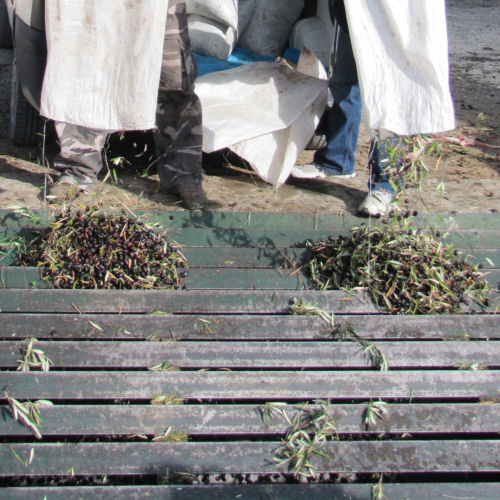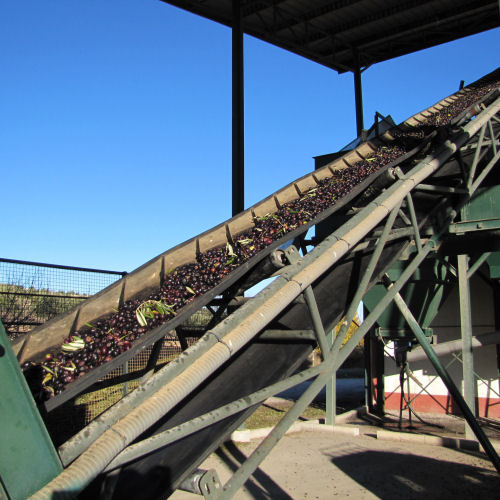
See this page for more information about our oil and HOW TO BUY IT.
HARVESTING THE OLIVES
Every December we pick our olives at the cortijo and take them to the olive cooperative to be pressed. Olives can be harvested any time between the beginning of December and the end of March and we prefer to pick ours as early as possible to avoid losing the crop to heavy winds or snow.
Large nets are placed on either side of each tree and the olives are knocked down from the higher branches using long, light sticks. The olives on the lower branches are combed off the trees with long-fingered, olive combs. The nets are carefully dragged down from tree to tree and the olives are bagged at the end of each row. It is not necessary to remove all branches and leaves as these removed at the cooperative. We generally take the bags to the cooperative every 3 or 4 days.
Unlike grapes, green and black olives grow on the same tree: the green olive is simply picked earlier in November.
 PRODUCING THE OIL
PRODUCING THE OIL
There are a large number of oil cooperatives throughout Andalucia, each producing a distinctive oil. When deciding where to take your olives, you will need to taste the oil that each produces to see which one you prefer. The cooperative we use is the Cooperativa Nuestra Señora del Perpetuo Socorro in Diezma in the province of Granada. They produce an extra virgin olive oil from early harvest, picual olives using mechanical means. The oil is versatile and can be used for roasting, sautéeing, shallow-frying, dressing and drizzling. It contains no preservatives and is 100% nut free.
 WHAT HAPPENS AT THE COOPERATIVE
WHAT HAPPENS AT THE COOPERATIVE
When it’s your turn, you first empty your bags of olives through the metal grid. The leaves and branches are then removed and the olives pass onto a conveyor belt and up to the weighing machine. As the olives proceed along the conveyor belt, a random sample of olives are collected for analysis. These are sent off the laboratory to measure the acidity level and this is used to calculate how many litres of olive oil you will be entitled to. Generally speaking, 5kg of olives produce 1 litre of oil. You can either opt to be paid in oil or in cash.
There are two way of collecting the olives: “vuelo” and “suelo”. The vuelo olives are collected directly from the tree whereas the suelo olives are picked up from the ground. A higher price is paid for the vuelo olives.
WORLD OLIVE OIL PRODUCTION
Spain produces around 50% of total global olive oil production. This is followed by Italy (15%), Greece (13%) and Turkey (5%).
Italy exports more oil than it produces and imports a lot of oil from Spain.
OLIVE OIL FAQ
See these links to BUY OUR OLIVE OIL and for our Olive Oil FAQ.












